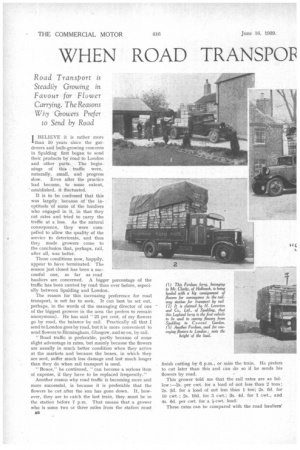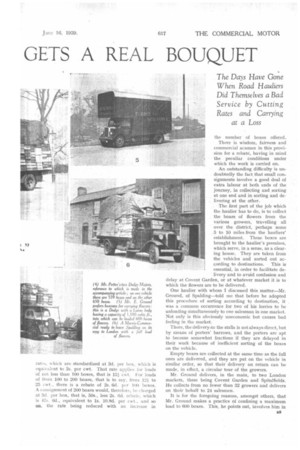WHEN ROAD TR ANSPOF GETS A REAL BOUQUET
Page 42

Page 43

Page 44

If you've noticed an error in this article please click here to report it so we can fix it.
Road Transport is Steadily Growing in Favour for Flower Carrying. The Reasons Why Growers Prefer
w Send by Road
The Days Have Gone When Road Hauliers Did Themselves a Bad Service by Cutting Rates and Carrying
at a Loss
BELIEVE it is rather more than 10 years since the gardeners and bulb-growing concerns in Spalding first began to send their products by road to London and other parts. The beginnings of this traffic were, naturally, small, and progress slow. Even after the practice had become, to some extent, established, it fluctuated.
It is to be confessed that this was largely because of the ineptitude of some of the hauliers who engaged in it, in that they cut rates and tried to carry the traffic at a loss. As the natural consequence, they were compelled to allow the quality of the service to deteriorate, and thus they made growers come to the conclusion that, perhaps, rail, after all, was better.
Those conditions now, happily, appear to have terminated. The season just closed has been a successful one, so far as road hauliers are concerned. A bigger percentage of the traffic has been carried by road than ever before, especially between Spalding and London.
The reason for this increasing preference for road transport, is not far to seek. It can best be set out, perhaps, in the words of the managing director of one of the biggest growers in the area (he prefers to remain anonymous). He has said "25 per, cent, of my flowers go by road, the balance by rail. Practically all that I send to London goes by road, but it is more convenient to send flowers to Birmingham, Glasgow, and so on, by rail.
" Road traffic is preferable, partly because of some slight advantage in rates, but mainly because the flowers are usually in much better condition when they arrive at the markets and because the boxes, in which they are sent, suffer much less damage and last much longer than they do when rail transport is used.
"Boxes," he continued, "can become a serious item of expense, if they have to be replaced frequently."
Another reason why road traffic is becoming more and more successful, is because it is preferable that the flowers be cut after the sun has gone down. If, however, they are to catch the last train, they must be in the station before 7 p.m. That means that a grower who is some two or three miles from the station must sb finish cutting by 6 p.m., or miss the train. He prefers to cut later than this and can do so if he sends his flowers by road.
This grower told me that the rail rates are as follow :-2s. per cwt. for a load of not less than 2 tons; 2s. 3d. for a load of not less than 1 ton; 2s. 6d. for 10 cwt.; 2s. 10d. for 5 cwt.; 3s. 4d. for 1 cwt., and 4s. 6d. per cwt. for a 4-cwt. load.
These rates can be compared with the road hauliers'
rates, which are standardized at 3d. per box, which is equivalent to 2s. per cwt. That rate applies for loads of not less than 100 boxes, that is 123: cwt. For loads of from 100 to 200 boxes, that is to say, from 12i to 25 cwt., there is a rebate of 2s. dd. per 100 boxes. A consignment of 200 boxes would, therefore, 15! charged at 3d. per box, that is, 50s., less 2s. 6d. rebate, which is 47s. 6d., equivalent to is. 10.8d. per cwt., and so on, the rate being reduced with an increase in
the number of boxes offered.
There is wisdom, fairness and commercial acumen in this provision for a rebate, having in mind the peculiar conditions under which the work is carried on.
An outstanding difficulty is undoubtedly the fact that small consignments involve a good deal of extra labour at both ends of the journey, in collecting and sorting at one end and in sorting and delivering at the other.
The first part of the job which the haulier has to do, is to collect the boxes of flowers from the various growers, travelling all over the district, perhaps some 5 to 10 miles from the hauliers' establishment. These boxes are brought to the haulier's premises, which serve, in a sense, as a clearing house. They are taken from the vehicles and sorted out according to destinations. This is essential, in order to facilitate delivery and to avoid confusion and delay at Covent Garden, or at whatever market it is to which the flowers are to be delivered.
One haulier with whom I discussed this matter—Mr. Ground, of Spalding—told me that before he adopted this procedure of sorting according to destination, it was a common occurrence for two of his lorries to be unloading simultaneously to one salesman in one market. Not only is this obviously uneconomic but causes bad feeling in the market.
There, the deliveripto the stalls is not always direct, but by means of porters' barrows, and the porters are apt to become somewhat fractious if they are delayed in their work because of inefficient sorting of the boxes on the vehicle.
Empty boxes are collected at the same time as the full ones are delivered, and they are put on the vehicle in similar order, so that their delivery on return can be made, in effect, a circular tour of the growers.
Mr. Ground delivers, in the main, to two London markets, these being Covent Garden and Spitalfields. He collects from no fewer than 32 growers and delivers on their behalf to 24 salesmen.
It is for the foregoing reasons, amongst others, that Mr. Ground makes a practice of confining a maximum load to 600 boxes. This, he points out, involves him in B8
insurance to the extent of not less than 2200 value per load and, at some parts of the season, even this is not sufficient to cover the value, since each box may at times be worth from 15s. to L1..
I should mention, perhaps, that a box holds 10 bunches of tulips, or 30 bunches of daffodils, a bunch consisting of 12 flowers. One of the troubles with which hauliers have to contend is the risk of loss of boxes of flowers actually in the market.
Mr_ Ground differs from some of his contemporaries in this trade, inasmuch as he is of opinion that boxvans are better adapted for that class of work than open lorries, which are more commonly employed. He thinks vans are better for several reasons, amongst which may be cited the fact that they eliminate the need for roping and sheeting and that the flowers are not so cold in transit, during the winter months. The vans he employs have a capacity of 1,100 cubic ft., which is sufficient to accommodate the 600 boxes which he regards as the most convenient load. This traffic commences just before Christmas, when the hauliers bring to market hothouse-grown flowers, largely for Christmas decorations.
• When the Glass Season Begins • So far as Mr. Ground is concerned, there is at that time only about one load of flowers per day. This is the beginning of what is called the glass season. Mr. Ground starts with one vehicle and later puts two vehicles into operation and runs in this way from December until about the second week in May.
When the outdoor season begins, he is conveying 800 boxes per day. That rises to about 2,800 by Easter and continues, so far as he is concerned, at that maximum until the middle of May, when it begins to diminish again.
In the height of the season, his lorries are engaged for practically 24 hours per day, commencing on the Sunday afternoon of each week and finishing on the Satur day evening. The weekly mileage per vehicle is about 1,500. This work, of course, necessitates the employment of two drivers per vehicle, with a mate to assist each driver. During this part of the season haulage contractors get very little sleep !
The manner in which the traffic fluctuates, as between one grower and 'another, is best exemplified by what I was told by Mr. Potter, a haulage contractor, of Spalding. He dispatches as many as 3,000 boxes of flowers to London in a night. On the evening previous to my call, a vehicle had collected 742 boxes after 6 p.m. This load involved him in seven pick-ups. On the other hand, he often takes as many as 1,000 boxes from one grower.
Mr. Potter says that his traffic is from 20,000 to 30,000 boxes in a season. He uses Dodge 5-ton vehicles with 15-ft. bodies and racks over the cabs, and on these vehicles can take as many as 700 or even 800 ordinary boxes of flowers.
0 High Mileage on Flower Transport • The two vehicles which are depicted in one of our illustrations belong to Mr. Potter. They had just returned from Covent Garden, had been four hours on the road, and probably three or four hours collecting empties from Covent Garden. The number of salesmen from whom they had collected these boxes might be anything from four to eight. One of these Dodge vehicles has done 20,000 miles since December of last year, and the other 10,000 since February of this year.
When the tulip season is over, gladioli, lettuces and cabbages are taken by those hauliers who are in this district. There is also a considerable traffic in bulbs, from July to October. Some of the bulbs are put into cold storage at King's Lynn and there is return traffic from there to London, carrying 'Dutch imported bulbs. Bulbs are packed in crates weighing 2 cwt. each. In the winter season there is the sugar-beet traffic to keep these vehicles engaged.




















































































